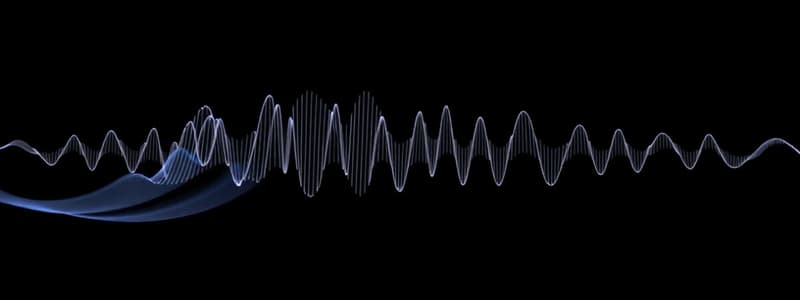Podcast
Questions and Answers
What happens to the observed frequency when a sound wave source approaches a stationary observer?
What happens to the observed frequency when a sound wave source approaches a stationary observer?
- The observed frequency increases. (correct)
- The observed frequency is unrelated to the source frequency.
- The observed frequency remains constant.
- The observed frequency decreases.
In the Doppler effect formula, what does the symbol $v_s$ represent?
In the Doppler effect formula, what does the symbol $v_s$ represent?
- The speed of the observer.
- The speed of sound in the medium.
- The speed of the sound source relative to the observer. (correct)
- The speed of the wave propagation.
Using the formula $f_o = \frac{f_s v}{v \pm v_s}$, which sign is used when the sound source is moving away from the observer?
Using the formula $f_o = \frac{f_s v}{v \pm v_s}$, which sign is used when the sound source is moving away from the observer?
- Positive sign. (correct)
- Both signs can be used.
- Negative sign.
- No sign needed.
Which of the following statements best describes the Doppler effect?
Which of the following statements best describes the Doppler effect?
What is the implication of observing a higher frequency sound when a source moves towards an observer?
What is the implication of observing a higher frequency sound when a source moves towards an observer?
Flashcards
Doppler Effect
Doppler Effect
The change in frequency of a wave for an observer moving relative to the wave source.
Doppler Effect Formula
Doppler Effect Formula
fo = fs * v / (v ± vs)
Observed Frequency
Observed Frequency
The frequency of a wave as measured by an observer.
Source Frequency
Source Frequency
Signup and view all the flashcards
Positive vs Negative Sign in Formula
Positive vs Negative Sign in Formula
Signup and view all the flashcards
Study Notes
Doppler Effect (CIE AS Level Physics 9702)
- The Doppler effect occurs when the frequency of a wave, like sound, changes depending on the relative motion between the source and the observer.
- When a sound source moves relative to a stationary observer, the observed frequency is different from the source frequency.
- The formula for calculating the observed frequency is (f_o = \frac{f_s v}{v \pm v_s}).
- (f_o) is the observed frequency.
- (f_s) is the source frequency.
- (v) is the speed of sound.
- (v_s) is the speed of the source relative to the observer.
- The plus sign (+) is used when the source moves away from the observer.
- The minus sign (-) is used when the source moves towards the observer.
Studying That Suits You
Use AI to generate personalized quizzes and flashcards to suit your learning preferences.




